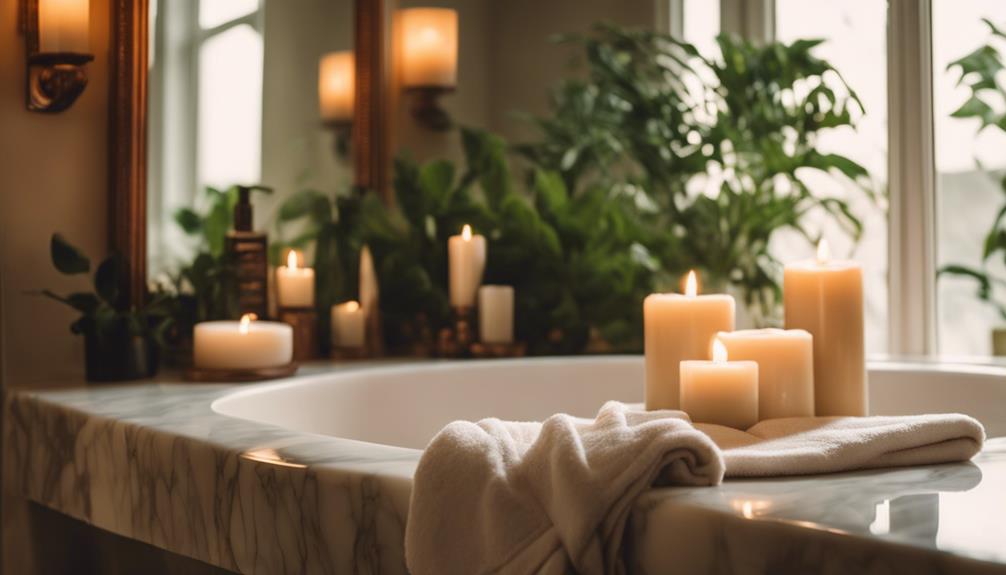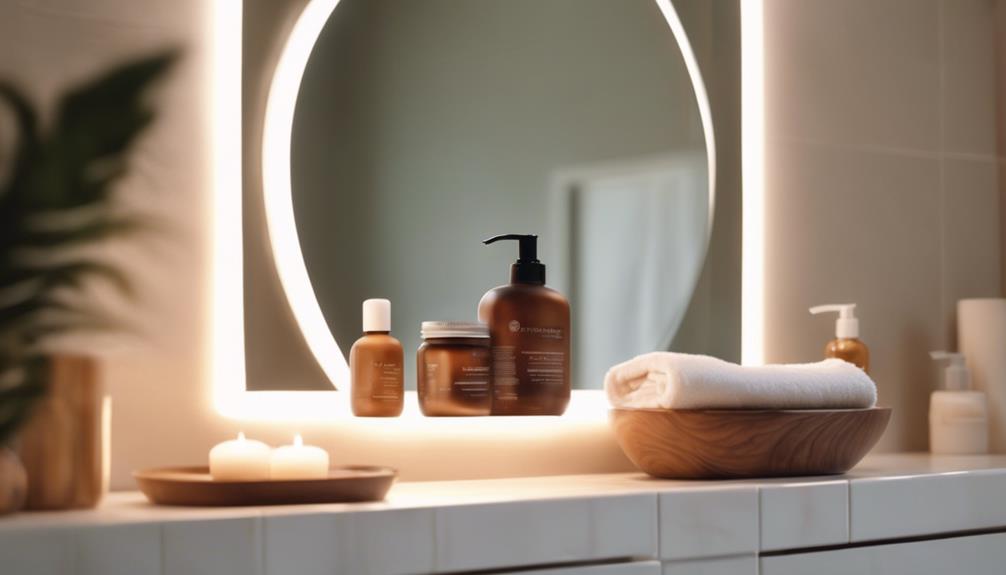Are you prepared for a radiant tan? Begin by exfoliating your skin to remove dead cells and make sure to hydrate well – your skin will appreciate it! Remember to wear protective eyewear; those little goggles are essential for shielding your eyes from UV rays. When choosing a tanning bed, opt for one with high UVA and low UVB rays for a safer tan. Keep your tanning sessions brief to avoid overexposure – 10 to 15 minutes is ideal for those with fair skin. After your tanning session, apply a moisturizing lotion and stay hydrated by drinking plenty of water. Interested in learning how to maintain your gorgeous tan? Stay tuned to discover some great aftercare tips!
Key Takeaways
- Always exfoliate and moisturize your skin before tanning to ensure an even and healthy tan.
- Use protective eyewear and quality tanning lotion to safeguard your skin and eyes during the session.
- Monitor your skin type and adjust tanning session duration to avoid overexposure and skin damage.
- Select a tanning bed with high UVA and low UVB rays for optimal tanning results while minimizing risks.
Tanning Preparation Essentials
Before you hit the tanning bed, make sure you properly prepare your skin to achieve an even and long-lasting tan.
Start by exfoliating your skin to slough off those pesky dead cells—think of it as giving your skin a fresh canvas for that golden glow.
Then, hydrate with a good moisturizer, because dry skin just won't cooperate with tanning. Avoid oil-based products, which can be like trying to paint on a wet surface—totally ineffective!
Remember, your skin's melanocytes love a little TLC before tanning, so treat them right.
Also, don't forget that tanning beds can be a great source of vitamin D—just like a sunny beach day, minus the sand in your shoes!
Protective Wear Selection

Selecting the right protective wear is essential for ensuring both your skin and eyes stay safe during your tanning sessions. You wouldn't head out in the sun without sunscreen, right? So, why not gear up for tanning too?
Here's what you should consider:
- Protective Eyewear: Always wear goggles to shield your eyes from harmful UV rays.
- Tanning Lotion: Use a quality indoor tanning lotion to keep your skin hydrated.
- Cover-up: For areas you want to protect, like your face, consider a light towel or clothing.
- Lip Balm: Don't forget your lips! A moisturizing lip balm can save them from drying out.
With these tips, you'll be rocking that tan safely and stylishly!
What's your favorite tanning accessory?
Understanding UV Levels

Understanding UV levels is essential for making informed decisions about your tanning sessions and ensuring your skin's safety. UV radiation can be both your best friend and worst enemy, so it's vital to know what you're dealing with. Here's a quick breakdown of UV types:
| UV Type | Description |
|---|---|
| UVA | Penetrates deep, bronzing skin |
| UVB | Causes sunburn and skin damage |
| UVC | Mostly filtered by the atmosphere |
Before hitting the tanning bed, check the UV index; it's like checking the weather before going outside! Knowing your skin type helps too, so you can enjoy a glow without the burn. So, what are your tanning goals?
Choosing the Right Tanning Bed

Finding the right tanning bed can greatly enhance your tanning experience and results. You want to make sure you're getting the best out of your sessions, so here are a few things to take into account:
- Equipment Quality: Look for beds with high UVA and low UVB rays for a safer tan.
- After-Bronzers: Choose beds equipped with after-bronzers for that even, sun-kissed glow.
- Bed Type: Think about stand-up beds for a full-body tan without those tricky angles.
- Eye Protection: Prioritize proper goggles to keep your peepers safe while you tan.
When you pick the right bed, it's like finding the perfect pair of shoes—your tanning sessions will feel way more comfortable and enjoyable!
Managing Session Duration

How can you effectively manage your tanning session duration to achieve the best results while minimizing risks?
First, know your skin type—if you're fair, start with shorter sessions. Tanning's like cooking; you don't want to burn your meal or your skin! Aim for 10-15 minutes initially, adjusting based on how your skin reacts.
Balance UV-A for instant color and UV-B for a lasting tan; think of it as getting a tan and then letting it settle. Keep track of time, because getting wrapped up in the moment can lead to overexposure.
Plus, don't use outdoor tanning products beforehand—your skin needs to stay irritation-free. Remember, a little patience goes a long way in achieving that golden glow!
Signs of Overexposure

If you notice redness or discomfort on your skin, it's a clear sign that you might be overexposed to UV rays. You don't want to turn into a lobster, right?
Here are some signs to watch for during your tanning sessions:
- Blistering or peeling – That's your skin saying “Whoa, stop!”
- Dizziness or nausea – Your body's way of asking for a break and some water.
- Sunburn-like symptoms – If you feel like you've spent a day at the beach without sunscreen, it's time to pause.
- Exhaustion or weakness – Listen to your body; it's telling you to hydrate and rest.
Keep an eye on these signs to guarantee your tanning experience stays safe and enjoyable!
Post-Tan Care Guidelines

Post-tan care is essential for maintaining your skin's health and prolonging that beautiful glow you've achieved.
First, slather on a hydrating lotion that's free from harsh chemicals—your skin will thank you! Remember, hydration isn't just for your skin; drink plenty of water to keep that glow even and smooth.
A few days after your tanning session, give your skin a gentle exfoliation to avoid any patchiness.
And here's a fun tip: skip outdoor tanning products; they can mess with your salon tan! Think of it like trying to wear two different outfits at once—it just doesn't work!
Focus on taking care of your skin, and you'll enjoy your fabulous tan for longer.
Resources for Safe Tanning

For safe tanning, it's crucial to utilize reliable resources that educate you on best practices and skin care techniques. You wouldn't want to plunge into a pool without checking the water first, right?
Here are some fantastic resources to help you tan safely:
- Skin Type Guides: Understand your skin type to tailor your tanning approach.
- Tanning Lotions Reviews: Find the best products that hydrate and enhance your tan.
- UV Index Apps: Use these to stay informed about safe tanning times.
- Safety Tips Articles: Immerse yourself in expert advice on avoiding overexposure and skin damage.
Frequently Asked Questions
Can I Tan if I Have Sensitive Skin?
If you have sensitive skin, it's essential to proceed with caution. Consider patch testing tanning products, start with shorter sessions, and use gentle, hydrating lotions to minimize irritation while achieving a sun-kissed glow.
What Should I Do if I Experience a Rash Post-Tan?
If you experience a rash post-tan, it's like your skin's throwing a tantrum! You should stop tanning immediately, apply soothing lotion, and consult a dermatologist if it doesn't improve quickly. Hydration's key too!
How Often Should I Exfoliate My Skin While Tanning?
You should exfoliate your skin once or twice a week while tanning. This helps remove dead skin cells, ensuring an even tan. Just avoid over-exfoliating, as it can irritate your skin and affect tanning results.
Are There Specific Products to Avoid While Tanning?
Imagine painting on a canvas; using the wrong products can ruin your masterpiece. When tanning, avoid mineral oils, sunscreen, and makeup, as they block absorption and hinder your tanning results. Stick to skin-friendly options for best outcomes.
Can I Tan During Pregnancy Safely?
You should avoid tanning during pregnancy. While some believe it's safe, experts recommend steering clear of tanning beds and excessive UV exposure to protect both your skin and your baby's health. Always prioritize safety first.
Why is it important to remove makeup before salon tanning for safety?
Before a salon tanning session, it’s crucial to ditch makeup before tanning to ensure safety. Leaving makeup on can block the pores, leading to skin irritation and uneven color absorption. It’s best to start with a clean, makeup-free face to achieve a flawless, streak-free tan.
Conclusion
So, you're all set to glow like a superstar while keeping your skin safe!
Remember, tanning doesn't have to be a guessing game. With the right prep, protective gear, and a good understanding of UV levels, you can enjoy your tanning sessions without worries.
Isn't it funny how a little sunshine can brighten your day, but too much can leave you feeling like a lobster?
So, take these tips to heart, and let your tanning journey be both fun and fabulous!









